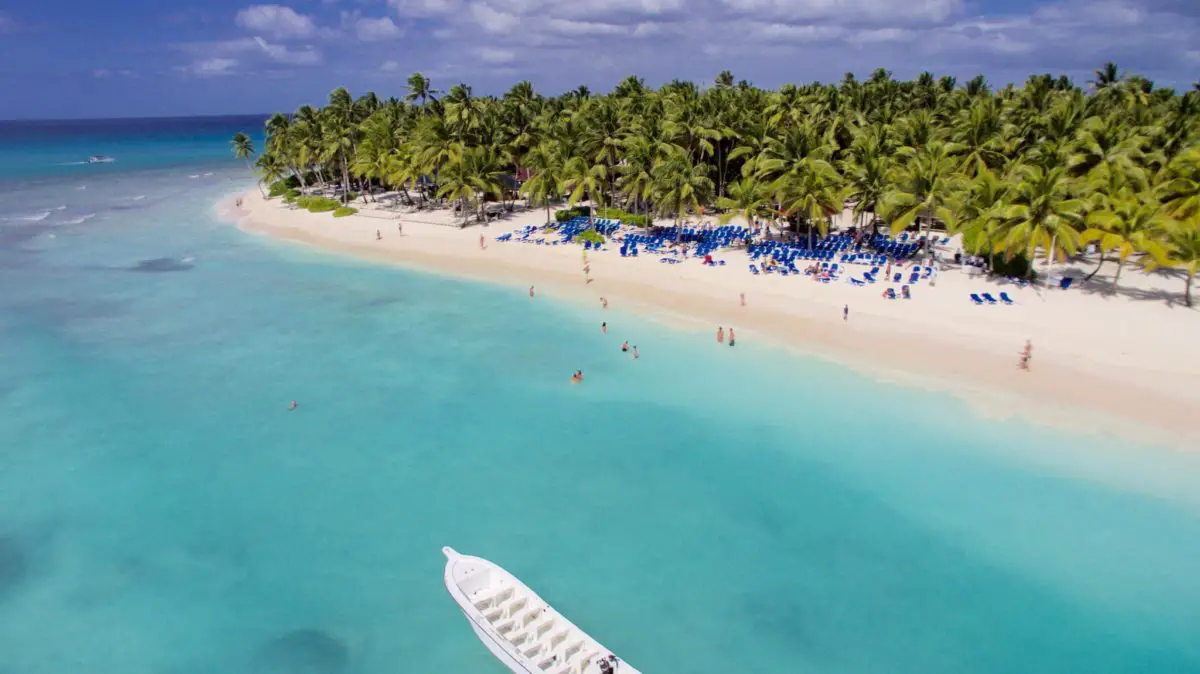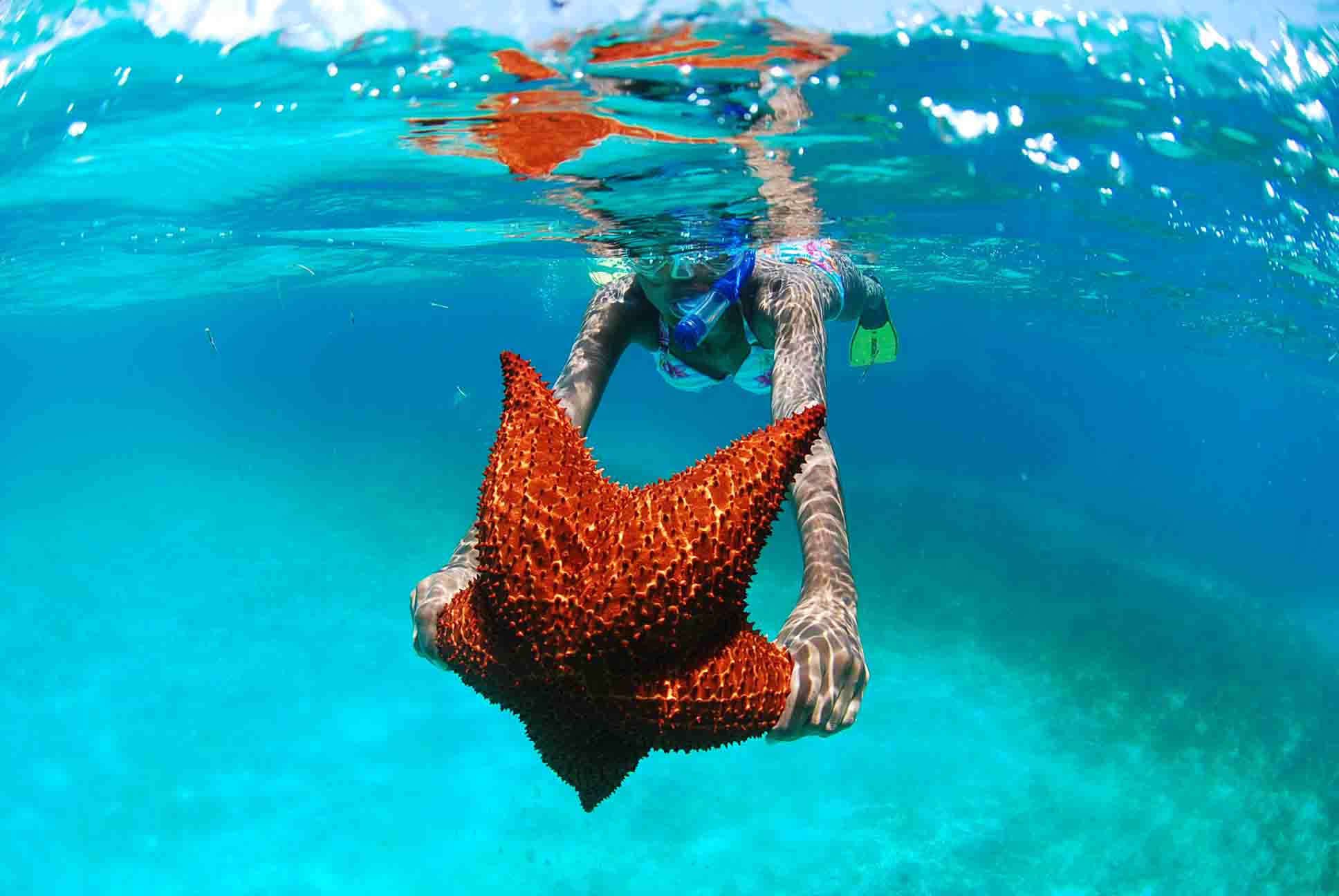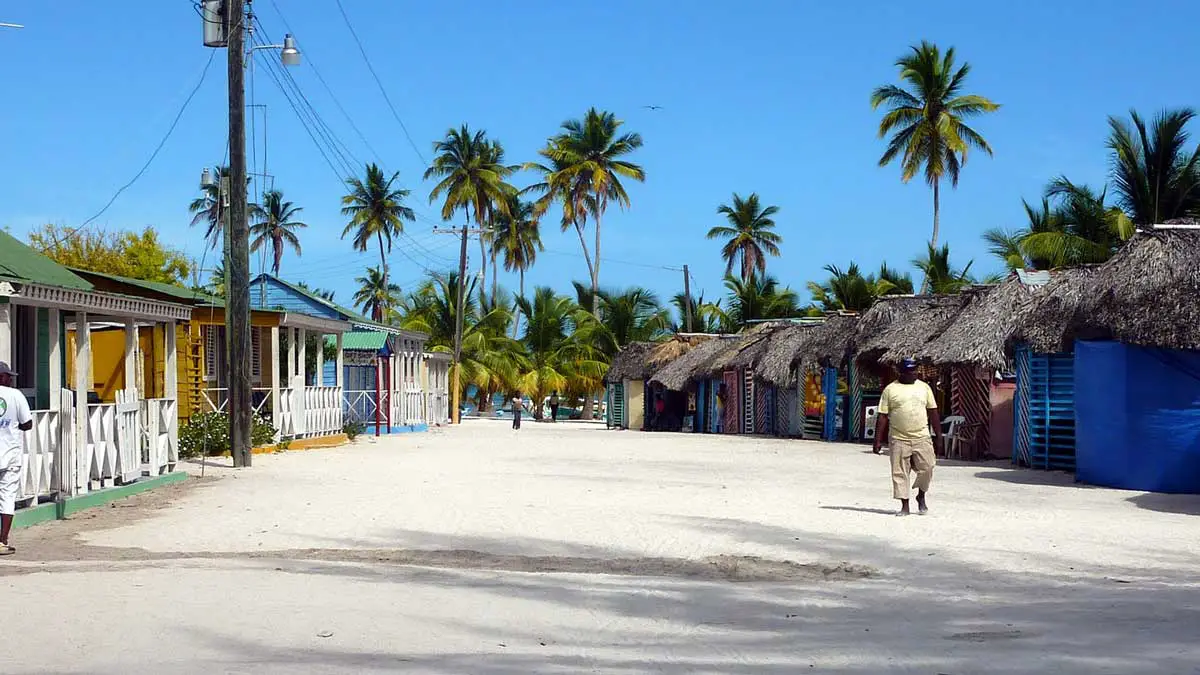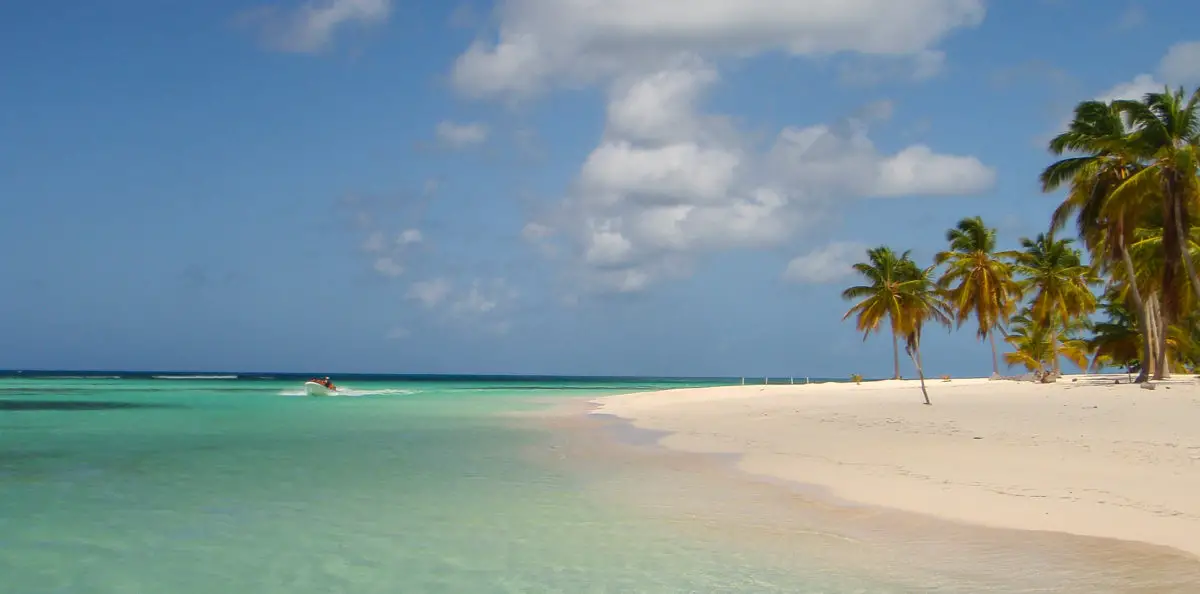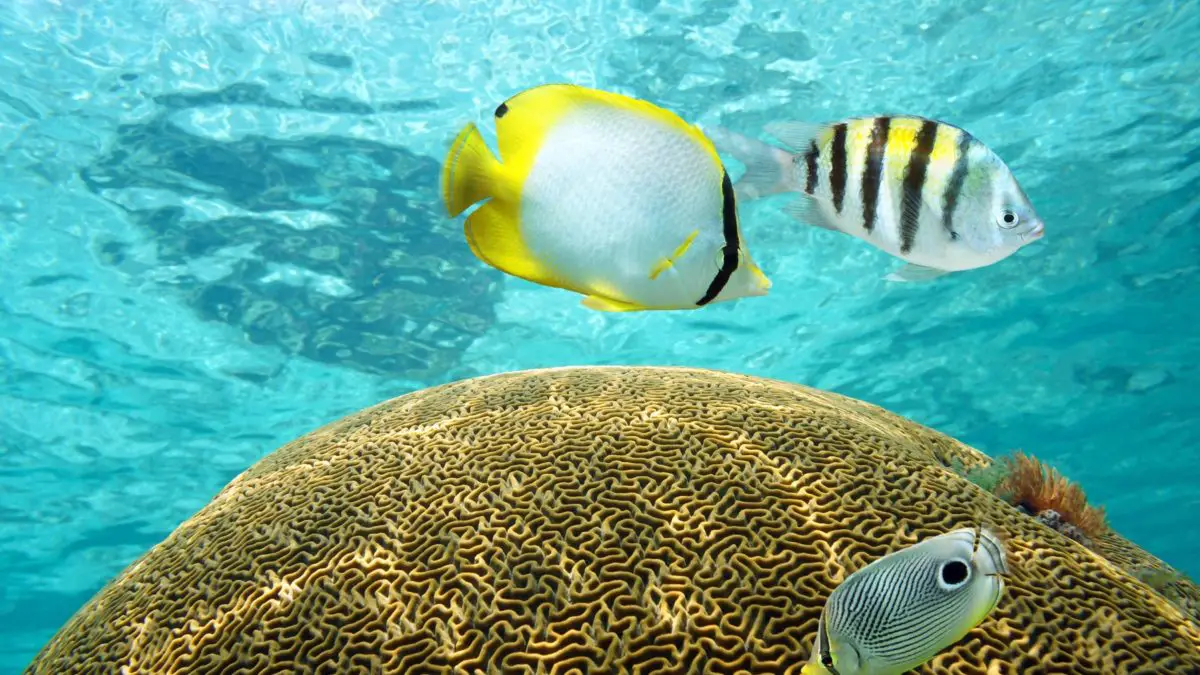The island of Saona, with its white sandy beaches, warm and crystalline waters of different shades of blue, is a paradise, but in addition to the beauty of its beaches, it also has a fauna and flora that can only be found in this place, as well as its inhabitants, very friendly people who will welcome you and make your stay on the island an unforgettable experience. Through this article we invite you to discover a little more of this island with unique characteristics.
Indice De Contenido
Where is Saona Island?
Saona Island is located south of the National Park of the East – Cotubanamá, in the extreme east of the Dominican Republic, off the coast of the province of La Altagracia, the surface of the island is 110 km2, with a length of 25 km and a width of 5 km, has a population of approximately 500 inhabitants.
It is considered a tropical paradise in the Caribbean, with miles of unspoilt beaches, white sand, crystal clear waters, palm and coconut trees, lagoons, mangroves and natural pools, as well as coral reefs, an underwater structure of calcium carbonate, the excrement of corals.
To get to the island of Saona, you have to take a boat, motorboat or catamaran from the town of Bayahibe, a fishing village located 20 kilometres from the city of La Romana, the trip takes approximately 30 minutes to 1 hour (depending on the means of transport used), after the journey, 400 kilometres from the coast in the middle of the sea, a stop will be made at a natural pool called Las Palmillas, considered to be the largest natural pool in the world, it has a depth of 1 metre, then continue the journey to Saona Island as the final destination.
The inhabitants of Saona receive between 2,000 and 2,500 tourists a day from all over the world, but mainly from Europe. In high season they can receive up to 3500 people, most of whom return to their hotels in the afternoon.
Hotels on Saona Island
It is advisable to spend at least one night on the island to be able to enjoy all that the place has to offer, as well as the tranquillity that is generated after the great majority of tourists have retired, the beautiful sunsets, among other kindnesses, although it is true that there are no luxury hotels, you can stay in one of the houses conditioned as lodgings in the town of Mano Juan, which are arranged so that you can spend a quality stay by the hospitable and excellent attention of its settlers.
The lodgings are rural and simple, not all of them have electricity or hot water for showers. But it is an experience not to be missed.
Mano Juan
Mano Juan is a very pretty village with colourful wooden houses typical of the Caribbean, located on the island of Saona, its inhabitants point out that the village is virgin, and its inhabitants are mostly dedicated to artisanal fishing with their own boats near its coasts, without major technological resources, only 3% of tourists visiting the island, have the opportunity to visit the village, as tour operators do not include a visit to Mano Juan in their itineraries.
Due to this situation, the village does not receive any foreign currency, which has not allowed the sustainable development of the village and is reflected in the low educational and social progress of the same, there is only one educational unit where they study from the first to the sixth grade of primary school, they also have precarious access to basic services such as drinking water, electricity is supplied by a power plant that the villagers maintain themselves.
The history
Adamanay was the original name of the island, given by the Taino Indians, a pre-Columbian indigenous people originally from the Bahamas, the Greater and Lesser Antilles and South America, specifically the mouth of the Orinoco River in Venezuela.
Christopher Columbus first set foot on the island of Saona on 14 September 1494, during his second voyage to the New World, and named it Bella Savonesa in honour of Michele da Cuneo, a wealthy Savonese who is considered the first tourist to travel to America, He was from the province of Savona, an Italian city in the Liguria region, and it was during this voyage that Columbus discovered that the place was another island and had nothing to do with Hispaniola, the name given to the Dominican Republic at the time.
On the island of Saona is the Cotubanamá cave, named in honour of the Taino chieftain who, in the early years of the 16th century, fled to the island of Saona to seek refuge from the atrocities and massacres committed by Nicolás de Ovando, governor of Hispaniola from 1502 to 1509.
During the time of President Leonidas Trujillo in the 1940s, the dictator gave the island to his relatives, who took over the economic activity of the coconut plantations in the area. Trujillo was responsible for the creation of the village of Mano Juan in 1944, bringing 14 families to the island, who have been the inhabitants of the area ever since. During the Trujillo dictatorship, Saona Island was also used as a prison for political dissidents.
On 16 September 1975, under the presidency of Joaquín Balaguer, the Cotubanamá National Park was created by Decree 1311.
Activities you can do on Saona Island
Once on Saona Island, you can do any of the following activities:
- Mano Juan: This is a good time to get to know the culture of the people who live on the island, so a visit to the fishing village of Mano Juan is a good alternative, where you can see its traditional wooden houses with bright colours, eat the local food in any of its restaurants and see the local art.
- Turtle recovery centre: On Saona Island you can visit the place where they protect the turtles of the area, there you can find out how they protect the turtles and their eggs and how they release the baby turtles.
- Flamingo Lagoon: A 30 minute walk will take you to the Flamingo Lagoon, where you can see many flamingos and a variety of birds native to the area. It is recommended to go in the morning when there are more birds.
- Snorkelling activities: The crystalline waters of the Caribbean Sea allow you to appreciate the marine fauna, which is abundant, through this activity you will be able to observe fish of different colours, starfish, corals, among others.
- Local food: You can enjoy an exquisite meal on the shore of the beach, there are several restaurants that prepare local food, if you want a lobster, you should order it at least one hour in advance.
Its extensive beaches
All the beaches on the island of Saona are spectacular, all are long, with crystal clear water and white sand, where you can see different shades of blue mangroves, coconut trees and palm trees, but the most popular are Playa del Gato and Playa del Canto de la Playa.
- El Gato beach: It is a place of exceptional beauty where you will find all the comforts, it is very suitable for families with small children, there are several restaurants on the beach.
- Canto de la Playa beach: The most popular and highly recommended beach is located at the south-eastern end of the island, you can get there on foot, taking the road to the village of Mano Juan is a journey of about an hour and you can enjoy the internal environment of the island, as semi-humid forests, scrub and mangroves, is a unique experience, however, if you want you can hire the services of a motorbike and in an average time of 10 minutes you will be in paradise, it is a very long beach, white sand and coconut trees.
Punta Roca
The island of Saona has a very slight elevation in its interior, which gives it the name of Punta Roca, a rugged area where there is a cave or grotto that served as a shelter for the natives, led by the cacique Cotubanamá, who were fleeing from the Spanish troops commanded by Juan Esquivel on the orders of the Spanish governor Nicolás Ovando in the 1500s. Interestingly, the tools that the natives took into the caves were discovered in 1912 by the American archaeologist Teodore de Booy.
National Park of the East – Cotubanamá
It was declared Cotubanamá National Park in 1975, under the government of President Joaquin Balaguer. The National Park has an extension of 430 m2, with an average temperature of 26°C, this area has three climatic zones, among which stand out the humid tropical forest, the dry subtropical forest and the transitional forest, which refers to the strip or transitional space that exists between the tropical forests and the dry subtropical, it also has a cave with images of indigenous gods.
Saona Island is located within the National Park of the East – Cotubanamá, it has an area of 110 Km2, the economic activity of Saona Island within the Park is mainly fishing and tourism and has some paradisiacal beaches.
The area where Saona Island is located is classified as one of the most important ecological reserves in the country, since the park protects the flora and fauna, as well as the geological aspects located in the area.
As it is a protected area, no construction of any kind is allowed along the coastline.
Features of Saona Island
The island of Saona, presents many spectacular sites that can be enjoyed by visitors and in addition to the beautiful beaches and water activities, you can also go hiking, as on the island is a grotto or cave, with a very interesting history, you can also learn about its excellent climate and its flora and fauna, then describes a little more of these peculiarities of this beautiful place:
Caves
The island of Saona has several caves and caverns, one of which is located 500 metres inland from the town of Catuano, in the mountains of Punta Roca; this place is called Cueva de Cotubanamá, in honour of the Taino chief Cotubanamá, Here, the cacique hid with his family while fleeing from the Spanish troops on the island of Hispaniola (now the Dominican Republic), and there are relics and indigenous archaeological sites, as well as pre-Hispanic rock art and petroleum deposits.
In order to access the caves, a number of interpretive trails have been created, which focus on the history of the site and the flora and fauna of the area.
The climate
The average temperature of the island of Saona is 30°C, which is very pleasant to spend the days of relaxation, however the climatic behaviour is for the zone:
- From January to April the temperature is around 35°C with little chance of rain.
In the month of May the temperature is 31°C with little chance of rain. - For the months of June to October the temperature is 32°C and for the month of October 17 days of rain are forecast.
- In November the temperature is recorded at 31°C with little chance of rain.
In December the temperature can reach 25°C and 10 days of rain are forecast.
Flora and fauna
The characteristic flora of Saona Island is catalogued as abundant and with a high percentage of endemic specimens, which means that they are typical of the area and cannot be found anywhere else outside of Saona Island. There is a great variety of plant species in its semi-humid forests, scrubland and mangroves, also known as salt forests, which are categorised as black, red, white and button mangroves.
The fauna of Saona Island is very varied and rich, with a wide variety of sea turtles, such as the loggerhead, hawksbill, green and hawksbill turtle, among the bird species we can mention the beach gull, the waders, the crowned pigeon and the green parrot, the latter considered endangered, in the area you can also observe the rhinoceros iguana and the fisher bat.
Se tienen registrados 40 especies de peces, 10 tipos de corales diferentes y 124 ejemplares diferentes de moluscos, el manatí que esta considerado como en peligro de extinción y delfines, igualmente se pueden encontrar bancos de langostas.
If you enjoyed this article, we invite you to visit the following links:
- Places to dive
- Best water sports
- Underwater Hotels

